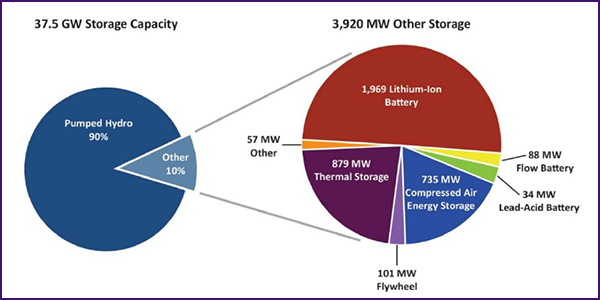NERC on Monday called for the creation of a task force to ensure grid planners are prepared for the coming surge in battery storage, which is expected to double to 4 GW by 2023.
The ERO said the task force should be formed by the Reliability and Security Technical Committee (RSTC) and should study “the forward-looking implications” of battery energy storage systems (BESS) and their impact on bulk power system reliability and resilience.
The directive comes in a new report, “Impacts of Electrochemical Utility-Scale Battery Energy Storage Systems on the Bulk Power System.”
“As we continue to assess the implications created by the integration of cutting-edge technologies to the electrical grid and the increasing amount of projected battery storage in the future, industry and regulators must pay more attention to bulk power system-connected battery energy storage systems,” said Thomas Coleman, NERC’s chief technical adviser of engineering and standards.
The report, which focused on standalone BESS and hybrid resources — BESS connected with solar or wind — also recommended that:
- system planners prepare for an increase in the “critical mass” of battery storage and ensure that it provides the essential reliability services to maintain BPS reliability, security and resilience. Planners must understand the impact of battery size, location and operating characteristics on maintaining reliability, NERC said, as well as batteries’ value as a complement to variable wind and solar resources.
- planners conduct studies to determine the dynamic stability impacts of interconnecting battery storage and its ability to provide capacity to meet long-term and contingency reserve margin requirements.
- entities reporting on batteries use consistent metrics and improve both their data and their reporting methods. “As energy storage systems become more prolific, accurate and timely data will be essential for both system planners and operators. The Institute of Electrical and Electronics Engineers (IEEE) should update the IEEE Standards to reflect any implications of battery storage systems,” it said. “The GADS Working Group should ensure that battery storage is accurately reflected in their data capturing protocols.”
U.S. BPS-connected battery energy storage power capacity (July 2020) | NERC
It concluded that existing reliability standards “adequately reflect battery storage as a generator, ensuring that the NERC TPL and MOD standards are applicable to the current number of BESS on the BPS.” But it called for a “gap analysis” to identify changes that will be needed in the future from both the growth of BESS and its additional functions.
Uses

Operating reserves and ancillary services (frequency regulation and voltage support) represent the lion’s share of BPS-connected storage capacity, with smaller amounts used for energy arbitrage, peaking capacity, black start and deferrals of transmission and distribution upgrades.
NERC recently conducted a joint study with WECC that highlighted the ability of BESS to provide fast frequency response (FFR) to avoid using under-frequency load shedding (UFLS) in response to generation losses. The study found that strategically located BESS provide effective FFR to avert UFLS.
“The team found that by altering the size of the BESS at different locations, it was able to inject power to arrest the frequency nadir,” NERC said. “While the location of this injection generally did not matter in relationship to interconnection-wide grid support, certain local stability problems may be exacerbated or resolved solved by using this BESS capability.”
Growth
The U.S. and Canada currently have 37.5 GW of storage capacity, 90% of it pumped hydro. Of the remaining capacity, more than half is lithium-ion batteries, which have matured because of their use in electric vehicles. “There are many electricity storage technologies at or near commercial viability with many more at various stages of development,” NERC noted.
The U.S. Department of Energy projects that 35% of the nation’s energy will come from wind (404 GW) and 27% from solar PV (632 GW) by 2050. BloombergNEF projects worldwide energy storage installations (including EVs but excluding pumped hydropower) will grow from 9 GW in 2018 to 1,200 GW of lithium-ion batteries by 2050. The U.S. is adding storage faster than any other country.
The largest battery in the U.S. is expected online later this year: Florida Power and Light’s 409-MW/900-MWh Manatee Energy Storage Center, which will pair storage with solar. Last April, Southern California Edison inked the nation’s largest-ever purchase of battery storage: 770 MW/3,080 MWh.
The top four states with facilities operating or under construction are California, Illinois, West Virginia and Texas, representing more than half of the total installed battery storage in the U.S.
Hybrids
According to the Energy Information Administration, the number of hybrid renewable-BESS rose from 19 in 2016 to 53 in 2019 and will double by 2023.
EIA says nine states comprise 90% of the operating hybrid capacity in the U.S., with Texas holding 46% of the total. “Although nearly 25% of the total United States battery capacity is installed as part of a hybrid system, only 1% of total wind capacity and 2% of total solar capacity is part of a hybrid system,” NERC said.
An ERO working group is currently drafting guidance on the application of the bulk electric system definition to BESS and hybrid resources and how owners of such facilities will have to register them.







